Abralia astrosticta
Kotaro Tsuchiya and Richard E. YoungIntroduction
A. astrosticta is a relatively large species in the genus attaining 70mm DML. This species is a component of mesopelagic boundary community in Hawaiian waters (Reid et al., 1991).
Brief diagnosis:
An Abralia (Astrabralia) with ...
- indistinct longitudinal strips of photophores on mantle and head.
Characteristics
- Tentacles
- Clubs with about four hooks on ventral side.
- Club manus with two rows of large suckers on dorsal side.
- Arms
- Right ventral arm of male hectocotylized.
- Hectocotylus with two subequal sized off-set flaps.
- Head
- Beaks: Descriptions can be found here: Lower beak; upper beak.
- Beaks: Descriptions can be found here: Lower beak; upper beak.
- Photophores
- Eye photophores
- Five large silvery organs subequal in size.
- Five large silvery organs subequal in size.
- Integumental Photophores
- Ventral mantle with scattered arrangement of organs forming very indistinct longitudinal strips.
- Ventral head with three indistinct, longitudinal stripes of organs.
- Large class of integumental photophores unusually large.
- Terminal Arm Photophores
- Arm IV with four large ovoidal photophores at tip and photophores not encased in chromatophores.
- Terminal suckers lost on oral side of arms IV opposite photophores in both sexes.
- Caudal Photophores
- Near mantle apex, a pair of ovoidal photophores buried in tissue.
 Click on an image to view larger version & data in a new window
Click on an image to view larger version & data in a new window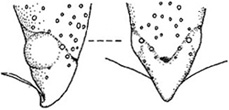
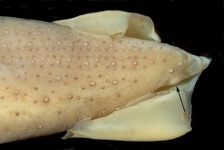
Figure. Caudal photophores of A. astrosticta. Left - Side and ventral views of, presumably, a mature squid. Drawings from Tsuchiya and Okutani (1989). Right - Ventral and slightly oblique view of the right caudal photophore (arrow), immature female. Photograph by R. Young.
- Eye photophores
Comment
The large photophores at the tips of arms IV, which is shared with A. asrolineata, is similar to the arrangement in genus Abraliopsis except that they are somewhat smaller and lack the black chromatophores that completely surround the photophores in Abraliopsis (In Abraliopsis the chromatophores, of course, retract during light emission).
Life history
Paralarvae
Paralarva of present species is characterized by:
- Integumental photophores very large.
- Caudal photophores barely apparent at 3.2mm ML.

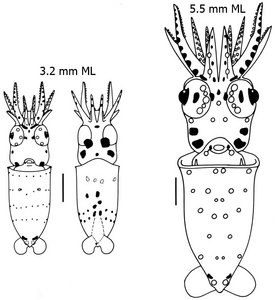
Figure. Ventral and dorsal views of A. astrosticta, Hawaiian waters. Scale bar is 1 mm. Note that the caudal photophores are detectable in both paralarvae. Drawings from Young and Harman (1985
(Young and Harman, 1985)
Distribution
Vertical distribution
A. astrosticta is a member of the mesopelagic boundary community in Hawaiian waters (Reid et al., 1991; Young, 1995). Adult specimens were caught at the bottom in 110 and 180m in Hawaii by gillnet and shrimp trawl. Juveniles were caught between 10 and 130m deep at night near Hawaii by pelagic trawls (Young, 1978).
Based on this sparse data, A. astrosticta is thought to inhabit near-bottom waters during the day at upper mesopelagic depth or shallower (i.e., waters with relatively high light levels) as indicated by the large size of their ventral photophores. At night they move into shallower waters, and presumably, move further off the ocean floor (Young, 199? ****)
Geographical distribution
This species was first described from Hawaiian waters. Distribution of the species includes the Ryukyu Islands (Tsuchiya, 1993), the Philippine Sea (Nesis and Nikitina, 1988), Hawaiian waters (Young, 1978; Burgess, 1992), New Zealand and western North Australia (Riddell, 1985; Lu and Philipps, 1985), and eastern North Australia.
References
Burgess, L.A. 1991. Squids of the Genus Abralia (Cephalopoda) from the Central Equatorial Pacific with a Description of Abralia heminuchalis, New Species. Bulletin of Marine Science, 49(1-2)(1991):113-136. [Published 29 January 1992]
Lu and Philipps, 1985. Nesis,K.N. and I.V. Nikitina. 1987. Redescription of Abralia steindachneri and Revision of Subgeneric Systematics of the Genus Abralia (Cephalopoda, Enoploteuthidae). Zoologichesky Zhurnal, 66(11):1693-1705.
Reid, S. B., J. Hirota, R. E. Young and L. E. Hallacher 1991 -- Mesopelagic-boundary community in Hawaii: micronekton at the interface between neritic and oceanic ecosystems. Mar. Biol. 109: 427-440.
Tsuchiya, K. 1993. Distribution and zoogeography of the family Enoploteuthidae in the Northwest Pacific. In: Okutani, T., O’Dor, R. K. and Kubodera, T. (eds.) 1993. Recent advances in fisheries biology (Tokai University Press. Tokyo). pp. 571-585.
Tsuchiya, K. 2000. Illustrated book of the Enoploteuthidae. In: Okutani T., ed. True face of Watasenia scintillans. Tokai University Press, Tokyo, p 196–269. (in Japanese)
Young, R. E. 1978. Vertical distribution and photosensitive vesicles of pelagic cephalopods from Hawaiian waters. Fish. Bull., 76: 583-615.
Young, R.E. 1995. Aspects of the natural history of pelagic cephalopods of the Hawaiian mesopelagic-boundary region. Pacific Science, 49:143-155.
Title Illustrations

| Scientific Name | Abralia astrosticta |
|---|---|
| Location | Off Rongelap Atoll, Marshall Islands |
| Comments | Large photophores of tail and arm IV tips, not visible. |
| Reference | Burgess, L.A. 1991. Squids of the Genus Abralia (Cephalopoda) from the Central Equatorial Pacific with a Description of Abralia heminuchalis, New Species. Bulletin of Marine Science, 49(1-2)(1991):113-136. [Published 29 January 1992] P. 131, Fig. 5B (contains unpublished illustrations of A. astrosticta by G. L. Voss). |
| Sex | Female |
| View | Ventral |
| Size | 54 mm ML |
| Copyright | © 1991 Bulletin of Marine Science |
About This Page
Drawing from Burgess (1991, p. 131, Fig. 5B) printed with the Permission of the Bulletin of Marine Science.

Tokyo University of Fisheries, Tokyo, Japan

University of Hawaii, Honolulu, HI, USA
Page copyright © 2018 and
 Page: Tree of Life
Abralia astrosticta .
Authored by
Kotaro Tsuchiya and Richard E. Young.
The TEXT of this page is licensed under the
Creative Commons Attribution-NonCommercial License - Version 3.0. Note that images and other media
featured on this page are each governed by their own license, and they may or may not be available
for reuse. Click on an image or a media link to access the media data window, which provides the
relevant licensing information. For the general terms and conditions of ToL material reuse and
redistribution, please see the Tree of Life Copyright
Policies.
Page: Tree of Life
Abralia astrosticta .
Authored by
Kotaro Tsuchiya and Richard E. Young.
The TEXT of this page is licensed under the
Creative Commons Attribution-NonCommercial License - Version 3.0. Note that images and other media
featured on this page are each governed by their own license, and they may or may not be available
for reuse. Click on an image or a media link to access the media data window, which provides the
relevant licensing information. For the general terms and conditions of ToL material reuse and
redistribution, please see the Tree of Life Copyright
Policies.
- Content changed 29 December 2009
Citing this page:
Tsuchiya, Kotaro and Richard E. Young. 2009. Abralia astrosticta . Version 29 December 2009 (under construction). http://tolweb.org/Abralia_astrosticta/19652/2009.12.29 in The Tree of Life Web Project, http://tolweb.org/




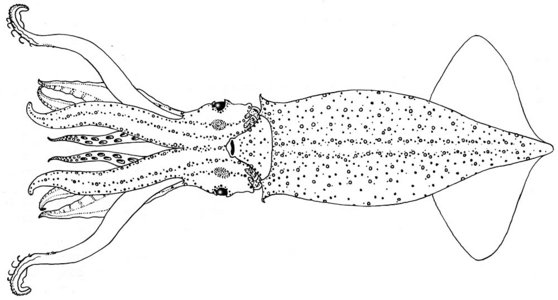
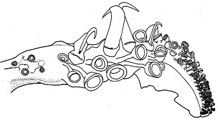
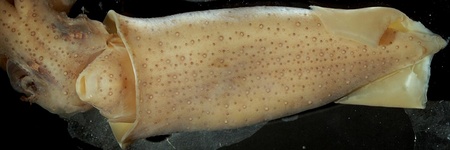
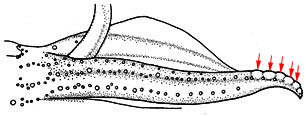



 Go to quick links
Go to quick search
Go to navigation for this section of the ToL site
Go to detailed links for the ToL site
Go to quick links
Go to quick search
Go to navigation for this section of the ToL site
Go to detailed links for the ToL site